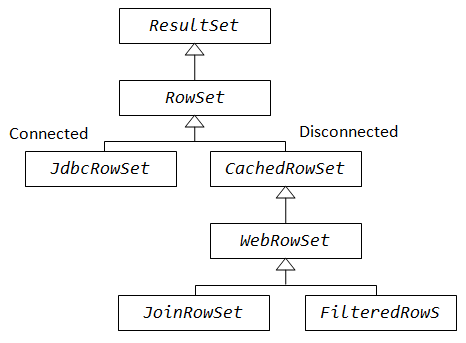Using JDBC FilteredRowSet - Simple Example
This post shows how to use a FilteredRowSet object. It lets you filter the number of rows that are visible in a RowSet object so that you can work with only the relevant data that you need. You may decide how you want to “filter” the data and apply that filter to a FilteredRowSet object. In other words, the FilteredRowSet object makes visible only the rows of data that fit within the limits you set.
You may know a JdbcRowSet object, which always has a connection to its data source, so you can do filtering with a query to the data source (using WHERE clause which defines the filtering criteria). A FilteredRowSet object provides a way for a disconnected RowSet object for filtering without having to execute a query on the data source, consequently avoiding having to get a connection to the data source and sending queries to it.

There are two main steps to use the FilteredRowSet:
- Create a new filter (an implementation of Predicate interface).
- Use your filter (setting a filter to your FilteredRowSet).
Create a new filter
You need to implement the evaluate method, which accepts a Rowset object. The documentation about this method says:
This method is typically called a
FilteredRowSetobject internal methods (not public) that control theRowSetobject’s cursor moving from row to the next. In addition, if this internal method moves the cursor onto a row that has been deleted, the internal method will continue to ove the cursor until a valid row is found.
Other methods, like evaluate(Object value, int column) and evaluate(Object value, String columnName), are called when you are inserting new rows to a FilteredRowSet instance.
My example tries to match any regular expression pattern, which was set during a filter initialization. If a pattern found, method returned true (= yes, we want this row).
/**
* Search Filter for {@link FilteredRowSet}
*
* @author pavel.sklenar
*
*/
class SearchFilter implements Predicate {
private Pattern pattern;
public SearchFilter(String searchRegex) {
if (searchRegex != null && !searchRegex.isEmpty()) {
pattern = Pattern.compile(searchRegex);
}
}
public boolean evaluate(RowSet rs) {
System.out.println("SearchFilter.evaluate called ");
try {
if (!rs.isAfterLast()) {
String name = rs.getString("name");
System.out.println(String.format(
"Searching for pattern '%s' in %s", pattern.toString(),
name));
Matcher matcher = pattern.matcher(name);
return matcher.matches();
} else
return false;
} catch (Exception e) {
e.printStackTrace();
return false;
}
}
public boolean evaluate(Object value, int column) throws SQLException {
throw new UnsupportedOperationException("Not supported yet.");
}
public boolean evaluate(Object value, String columnName)
throws SQLException {
throw new UnsupportedOperationException("Not supported yet.");
}
}
Use your filter
You need to set your new instance of Predicate interface to your FilteredRowSet using method setFilter:
usersRS.setFilter(new SearchFilter("^[A-L].*"));
The complete example of my code is bellow. To run it, you need to add an H2 library (a memory database driver) to your classpath, e.g. available here.
/**
* Example usage of {@link FilteredRowSet}
*
* @author pavel.sklenar
*
*/
public class FilteredRowSetTest {
/*
* Sample names for test
*/
private static final String[] NAMES = { "Bill Gates", "Steve Jobs",
"Mark Zuckerberg", "Alan Turing", "Linus Torlvalds" };
/**
* The main class to run test
*/
public static void main(String[] args) throws Exception {
Connection c = DriverManager.getConnection("jdbc:h2:mem:db1", "test",
"test");
// Just only prepare data for test
prepareData(c);
RowSetFactory rsf = RowSetProvider.newFactory();
FilteredRowSet usersRS = rsf.createFilteredRowSet();
usersRS.setCommand("select * from USER");
usersRS.execute(c);
usersRS.setFilter(new SearchFilter("^[A-L].*"));
dumpRS(usersRS);
}
/**
* Dump {@link ResultSet}
*
* @param rs
* input{@link ResultSet} to dump
* @throws SQLException
* @throws Exception
*/
public static void dumpRS(ResultSet rs) throws SQLException {
ResultSetMetaData rsmd = rs.getMetaData();
int cc = rsmd.getColumnCount();
while (rs.next()) {
for (int i = 1; i <= cc; i++) {
System.out.println(rsmd.getColumnLabel(i) + " = "
+ rs.getObject(i) + " ");
}
System.out.println("");
}
}
/**
* Prepare data for test
*
* @param c
* {@link Connection} will be used to prepare data
* @throws SQLException
*/
private static void prepareData(Connection c) throws SQLException {
c.createStatement().execute("create table USER (name varchar(256))");
PreparedStatement prepareStatement = c
.prepareStatement("insert into USER (name) values (?)");
for (String name : NAMES) {
prepareStatement.setString(1, name);
prepareStatement.execute();
}
}
}
Output of the previous code:
ContainFilter.evaluate called
Searching for pattern '^[A-L].*' in Bill Gates
NAME = Bill Gates
ContainFilter.evaluate called
Searching for pattern '^[A-L].*' in Steve Jobs
ContainFilter.evaluate called
Searching for pattern '^[A-L].*' in Mark Zuckerberg
ContainFilter.evaluate called
Searching for pattern '^[A-L].*' in Alan Turing
NAME = Alan Turing
ContainFilter.evaluate called
Searching for pattern '^[A-L].*' in Linus Torlvalds
NAME = Linus Torlvalds
Resources
https://docs.oracle.com/javase/7/docs/api/javax/sql/rowset/FilteredRowSet.html
https://docs.oracle.com/javase/7/docs/api/javax/sql/rowset/Predicate.html
https://docs.oracle.com/javase/tutorial/jdbc/basics/filteredrowset.html